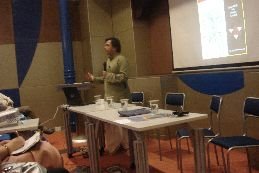

Last month we completed reading and pondering upon the wisdom of the Bhagavad Geeta...after that we celebrated by having lunch at 'Govinda' the restaurant in Iskcon...Let me share with you 2 verses from the Scripure.
Two Geeta Verses
Before rushing helter skelter to find God, let us start the search, by looking within ourselves.
What we find is sometimes not very pleasant.
Most people complain that they cannot change themselves.
What I feel and say to them is, don’t be too hard on yourself.
Look back! Do you react less to circumstances, than you used to, a few years ago?
If yes, then you are on the right track.
If one learns to communicate with oneself, one progresses spiritually, and one is never lonely.
If one learns to really meditate, one will look for only one boon, that of ‘peace’
And that happens when one accepts, that things are, the way they are.
See! No one is asking you to give up trying to change circumstances; to the way you would like them to be.
You can study hard and you may be a very bright student, but you could fall ill and fail the examinations.
One has to renounce oneself to the above outcome.
A more common example is about people who ‘kill’ themselves to please others, and end up being criticized.
To such people I advise: Enjoy the ‘service’ let that, be your reward, not the result of your action.
We will be, eventually judged by our true intentions, when we ‘acted’.
Not by what people ‘spoke’ about us.
This is what Krishna means, when he states, in the 47th verse of the 2nd Chapter in the Geeta, that our right is only over our actions, not over the fruits (outcome) of the actions.
He said:
Karmanyey Vaadhikaa rastey, Maa phaleshu KadaachanaaMaa karma phala hetur bhoor, Maa tey sangotswa, akarmanee
There is another verse in the Bhagvad Geeta, which I really like.
It is the 12th verse of the 12th chapter.
Krishna says:
Shreyo hi jnaanam abhyaasaat,jnaanaa dhyaanam vishishyateDhyaanaat karma phala tyaagasTyaagaat chhaantiranantaram
Which I would interpret thus:
Better than (ritual) practice is Knowledge (Gyaan)Better than knowledge is meditation,Better than meditation is, to renounce the fruit of your actions,
Note: Krishna does not ask you to renounce ‘actions’. He is asking to renounce its fruits.
(If one does the above) Peace immediately follows.
Read:
http://www.dalsabzi.com/Wisdom_Scrip/bhagvad_gita.htm
It was Radhashtami on the 1st of September...if you would like to know more about it, click:
http://dalsabzi.com/Language_Festivals/radhaashtami.htm
To read some points about an alternative Education Vision, Click and scroll down on:
http://dalsabzi.com/women_movement/wmppadv.htm
Shacune
www.dalsabzi.com




